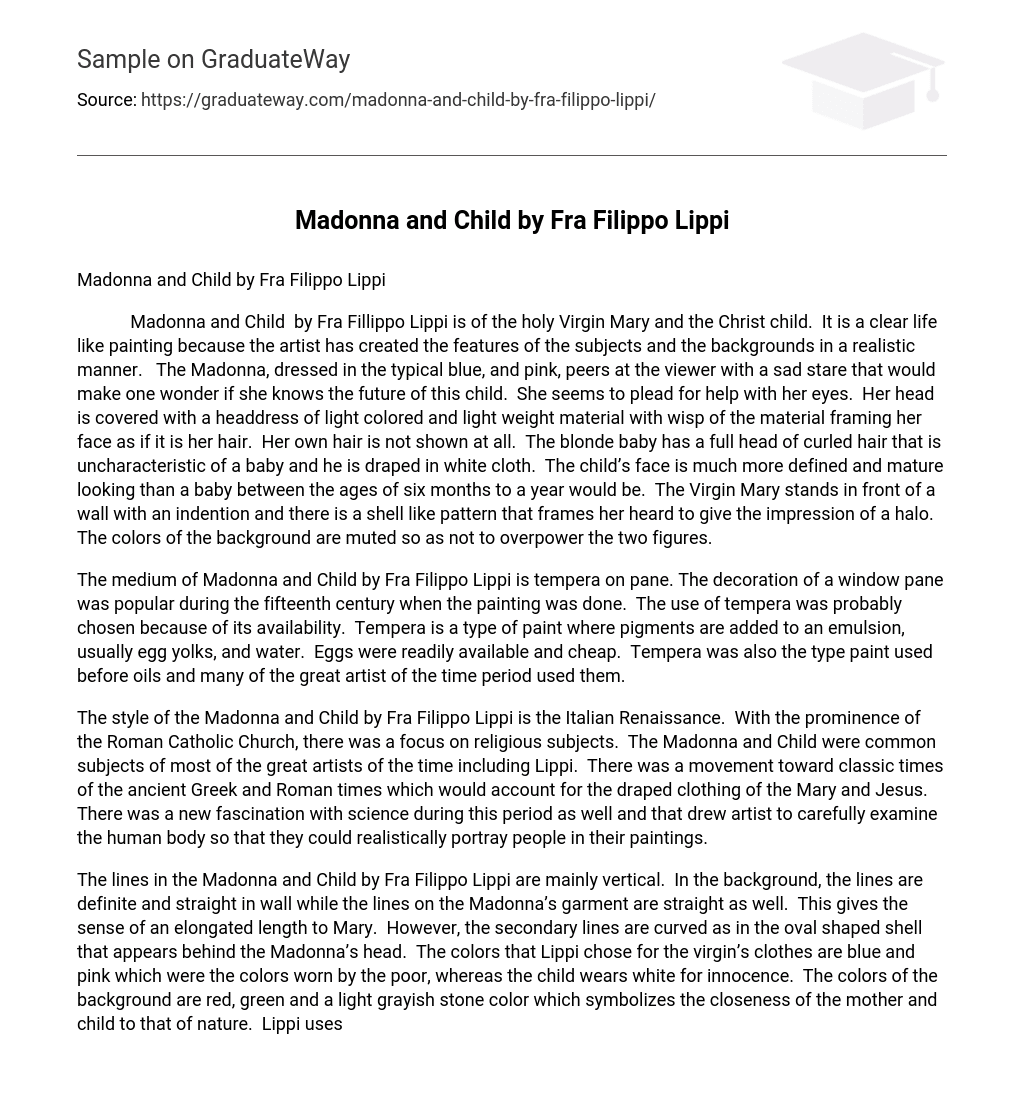Madonna and Child by Fra Fillippo Lippi is of the holy Virgin Mary and the Christ child. It is a clear life like painting because the artist has created the features of the subjects and the backgrounds in a realistic manner. The Madonna, dressed in the typical blue, and pink, peers at the viewer with a sad stare that would make one wonder if she knows the future of this child. She seems to plead for help with her eyes. Her head is covered with a headdress of light colored and light weight material with wisp of the material framing her face as if it is her hair. Her own hair is not shown at all. The blonde baby has a full head of curled hair that is uncharacteristic of a baby and he is draped in white cloth. The child’s face is much more defined and mature looking than a baby between the ages of six months to a year would be. The Virgin Mary stands in front of a wall with an indention and there is a shell like pattern that frames her heard to give the impression of a halo. The colors of the background are muted so as not to overpower the two figures.
The medium of Madonna and Child by Fra Filippo Lippi is tempera on pane. The decoration of a window pane was popular during the fifteenth century when the painting was done. The use of tempera was probably chosen because of its availability. Tempera is a type of paint where pigments are added to an emulsion, usually egg yolks, and water. Eggs were readily available and cheap. Tempera was also the type paint used before oils and many of the great artist of the time period used them.
The style of the Madonna and Child by Fra Filippo Lippi is the Italian Renaissance. With the prominence of the Roman Catholic Church, there was a focus on religious subjects. The Madonna and Child were common subjects of most of the great artists of the time including Lippi. There was a movement toward classic times of the ancient Greek and Roman times which would account for the draped clothing of the Mary and Jesus. There was a new fascination with science during this period as well and that drew artist to carefully examine the human body so that they could realistically portray people in their paintings.
The lines in the Madonna and Child by Fra Filippo Lippi are mainly vertical. In the background, the lines are definite and straight in wall while the lines on the Madonna’s garment are straight as well. This gives the sense of an elongated length to Mary. However, the secondary lines are curved as in the oval shaped shell that appears behind the Madonna’s head. The colors that Lippi chose for the virgin’s clothes are blue and pink which were the colors worn by the poor, whereas the child wears white for innocence. The colors of the background are red, green and a light grayish stone color which symbolizes the closeness of the mother and child to that of nature. Lippi uses shadows around the facial features of the Madonna to create her sad countenance. While the texture of the painting is smooth, there is a sense of depth to it.
I felt that the appeal of this painting came from its simple beauty and its sadness. The face of the Virgin Mary drew me to it because I knew that story of what was to make her sad in the future and the sadness of the rejection of society during with the birth of an infant before she was married. I feel that it is still a relevant subject today and I see this look in many faces in the present. I find the round sad face displaying innocence of her youth as well as her beauty. The child holds a fascination because I find that he is does not look realistic. The maturity symbolizes the knowledge that the child had.





